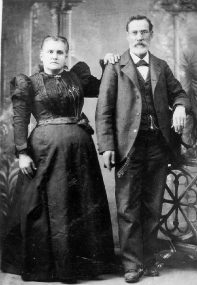

Perpetue and Lastie Broussard
 Lastie Broussard:
Lastie Broussard:by Kenneth A. Dupuy
Lastie Broussard was our clerk of court; he was our mayor, our town alderman; he was our state senator; he probably walked with a limp. End of story. Well, maybe not. I'll try to flesh out this man a little more.
Lastie was one of 11 children born to Aurelien and Coralie Broussard. The year of his birth was 1838, according to his tombstone, and 1837 according to his obituary. It was about 5 years before Father Megret bought the site of Abbeville, and about 6 years before Vermilion Parish was created. Broussard would figure prominently in the histories of both.
When Lastie's mother died at the age of 87, in 1899, she left many descendants. According to the Meridional, 4 of her children survived her. She also left 66 grandchildren, 165 great-grandchildren, and 3 great-great grandchildren.
Of the 66 grandchildren, 15 of them were born to Lastie and his wife Perpetue—6 sons and 9 daughters. At the age of 23, Lastie married Perpetue, age 15, in Abbeville on June 3, 1861, only two months after the firing on Fort Sumter by Confederate forces, and about a month before the first major battle of the Civil War—Bull Run. I wonder how much and how quickly news of the war trickled down to our little village.
Did the Broussards, as they said their vows, have an inkling that hostile forces would invade their town and interrupt tranquility in less than two years? Probably not, but Yankees did do some plundering in mid-November 1863. Testimony in a claim made by Auguste Olle, a baker in Abbeville, against the United States government is contradictory. F. D. Lege, who was parish constable and deputy sheriff during the war, testified that the "Federals" had not taken any animals when they came into town. Jean Abadie, another Abbevillian said that horses had been taken from the town. At least one shot was fired by a Union soldier. The bullet was fired at Dr. Hypolite Abadie who was shouting insults as the Yankees were pulling out of Abbeville, according to David C. Edmonds in his book, Yankee Autumn in Acadiana. Other than the indignity of foreign forces riding up and down our dusty streets, there was no Shermanesque destruction.
Now, back to the Broussards. To some extent, the success of parents is reflected in the lives of their children. Lastie and Perpetue must have been deeply pleased with their parenting in view of the lives of their offspring. At Lastie's death, L. O. Broussard was president of the Bank of Abbeville, while O. A. Broussard was the cashier. Olivier was a successful druggist in Rayne and J. O. Broussard was an attorney. Lastie's surviving daughters were married to Wm. Cade, Remy Broussard, Dr. R. J. Young, and J. F. Broussard. Perhaps the child this religious couple appreciated most was Olita. She became Sister Marie Mathilde of the Mount Carmel Order in New Orleans. She took the white veil in 1897.
An interesting bit of incidental information about Lastie's children is the fact that each of their first or middle names began with the letter "O." So unique was this naming of these children, that it made "Ripley's Believe It or Not" in 1938, according to John Elliott Cade, who wrote unpublished biographical sketches of Lastie and Perpetue. Imagine the number of descendants of this couple living in Abbeville today!
Lest we think that this couple's life was idyllic, let me tell you that when Mrs. Broussard died in 1907, four of her children had preceded her in death. One of these four, if my memory serves me correctly, died a most horrible death. This child seems to have backed into a huge container which held a boiling liquid of some sort. To have a child die is about as great a tragedy as anyone can experience, but to see one's child die so painfully must have compounded the mental anguish that these parents experienced. I reluctantly included this account to emphasize how terrible life could be even in those "good old days." The Broussards survived the deaths of their children, but surely they were left with scarred hearts, shrunken souls, and pitted minds.
As early as 1868, according to F. Feray's map of Abbeville, Lastie owned lots 81, 82, and 83 of Megret's portion of the town, and lots 39-42 of Boete's portion of the town. In time Lastie would own the entire city block (81-84, 89-92). In the mid 1970's, Ms. Kate Young, one of Lastie and Perpetue's granddaughters, told me that Lastie's residence was once located where the police station is today, on Charity Street. Ms. Young added that the boys' room, was one big dormitory upstairs, just like at the home of her other grandparents, Dr. and Mrs. F. D. Young.
During his lifetime, Lastie Broussard served Abbeville and the rest of the people of Vermilion Parish. The role for which he is best known is that of clerk of court. Visit the clerk's office and look at his picture and the pictures of the other clerks of court hanging on the wall. These men seem to be saying that they hope that they carried out their duties to the best of their abilities. Lastie had been Clerk of Court from May 1865 until sometime in 1888. In 1879, the new state constitution combined the separate offices of Recorder of Conveyances and Clerk of Court.

From 1868 through 1870 [yearly elections at that time], Lastie was mayor of Abbeville. In 1871, he was elected a town council alderman, and he was reelected to that position in 1872 and 1873. In 1875 and 1876, Lastie served the town council as secretary and treasurer. Once again he served as alderman in 1877 and 1878. Mr. Broussard served as alderman again, from 1882 through 1884. The town council met at the courthouse during those years. So, with his time spent in the courthouse as clerk of court, as mayor, and as an alderman, it was only natural that he became an integral member of the committee to select the plan for a new courthouse, following the destruction by fire of the courthouse in 1885.
Lastie Broussard must have spent considerable time in the courthouse as a lawyer, too. In July 1879, he passed the exam before the Supreme Court at Opelousas and was admitted to the bar. In January 1889, he and W. A. White formed a partnership; it was dissolved in July 1891. It is interesting that these two gentlemen continued "to do business at their old office and for their individual account." Later, Lastie formed a partnership with J. R. Kitchell. In 1899, W.W. Bailey joined the firm which became the Broussard, Kitchell & Bailey law firm. In 1908, Lastie resigned from the firm. His son, J. Otto, joined, and the firm's name became Kitchell, Bailey & Broussard.
In early 1892, Lastie Broussard, W. W. Edwards, and Dr. W. G. Kibbe were chosen as a right-of-way committee for the railroad. They assisted in obtaining the property upon which the Iberia and Vermilion railroad laid its twin ribbons of steel between New Iberia and Abbeville, thus binding these communities even more inseparably than before. There was at least one famous person who donated land so that the railroad could cross his land: Joseph Jefferson. He owned about 3,500 arpents of land at and extending from Orange Island, as his property on Lake Simmonet was called. We now know this body of water as Lake Peigneur; it has carried both names since at least the late 1800s. Anyway, Jefferson, who was residing in York County in the State of New York in April 1892, donated land a hundred feet wide and 6,848 feet in length—that's over a mile and a fourth—so that New Iberia and Abbeville could be connected by rails. Surely though, there must have been a right-of-way committee for Iberia Parish. Thus, it is unlikely that our committee members were involved in this transaction.
Lastie, W. W. Edwards and A. D. Martin became officers of the Vermilion Parish Immigration Association. As I am writing this article, I realize how frequently Lastie Broussard and Judge W. W. Edwards worked together on various committees of vital importance to Abbeville. Anyway, as I said in another article, this committee's function was to attract settlers with marketable skills. The committee was organized in 1878, while Lastie was on the town council, and was clerk of court. In 1880, the committee had had printed several thousand circulars which were distributed "throughout the union." Also, ads were run in newspapers and were still running in the Meridional in November 1882. At the end of this circular, Lastie's name was printed as "Laster," which is a shame because some people will not know who this "Laster" Broussard really was.
Broussard was elected vice-president of Abbeville's first firefighting organization: the Abbeville Fire Co. No. 1. In 1890, he was on the first board of the Abbeville Building and Loan Association. Lastie was a vice-president of this financial institution, and served as its attorney as well. In 1900, he was still on this board.
Also in 1900, Lastie took on another major role. This time he represented the people of the 11th District [St. Mary and Vermilion parishes] as a State Senator. I did not delve into his history as a senator, so I know of only one bill which he introduced in the Senate. It amended the voting law to allow illiterate voters assistance in preparing their ballots. The bill passed the Senate 31 to 5.
In addition to all the roles which Lastie played on Abbeville's stage, he also had a farm, which in and of itself isn't worth mentioning. However, Broussard employed a newly-arrived family of settlers who hailed from Switzerland. They arrived in this area at the beginning of 1886. They were the Stauffers. The news item of the day stated that "Mr. Stauffer and his five sons" were hired by Lastie to cultivate his farm. Perhaps it was in a gesture of appreciation that Mr. Stauffer promised that he would have a number of families emigrate from Switzerland to Vermilion Parish. In 1974, one of the descendents of these settlers told me that the Stauffers had arrived in New York and went to Chicago. There they reportedly bought a covered wagon and started out west for Texas. Evidently, they took the wrong off-ramp, in 1886, and ended up north of Abbeville on Lastie Broussard's farm! It was a lucky turn of events for Broussard and for Abbeville.
One final anecdote about Lastie Broussard. It illustrates the "Old West" tenor of life in Abbeville before the turn of the 20th Century. It emphasizes how Broussard's life almost ended too soon. The incident was reported in New Iberia's Sugar Bowl. On the last Sunday of August in 1875, Lastie Broussard and Capt. F. Feray got into a violent argument. Capt. Feray was a surveyor. In fact, I've talked about his 1868 map of Abbeville. His captaincy was earned on Civil War battlefields. We will never know what the argument was about, but when the smoke cleared, Lastie was down with two bullets in one of his legs. According to the newspaper, his "knee joint," was shattered. There was grave concern that Broussard might even die. Even if he didn't die, it was ventured that amputation would be required. However, two weeks later, the Sugar Bowl reported that Lastie, "Clerk of Court of the parish of Vermilion," was recovering from those wounds, and that amputation had not been necessary. Now you know why I said at the beginning of this article that he probably walked with a limp.
Despite near-mortal wounds of body and soul—his wife and several children had preceded him in death—Lastie Broussard survived and helped to make Abbeville and Vermilion Parish better places to live.